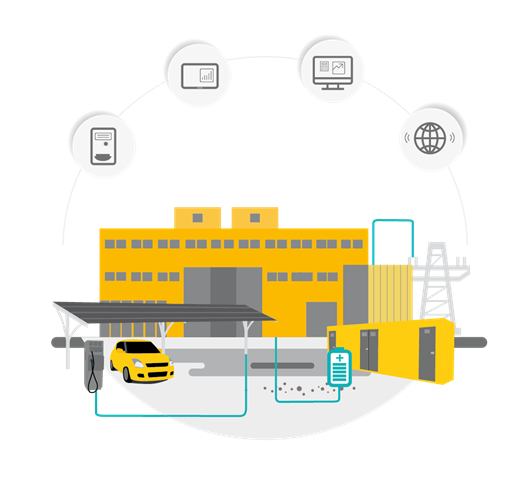City of Terni, Italy
Category: Distribution System
Location: Terni, Italy
The City of Terni is located 100 km northeast of Rome. ASM Terni is an Italian provider for natural gas, water and electric energy that owns and operates a 200 kW PV farm connected to the low-voltage network.
Trialling two different scenarios in Terni
An ELSA battery energy storage system consisting of six Renault Kangoo electric vehicle batteries is installed in a technical room together with its corresponding power and control modules. The storage system has a total capacity of 66 kWh and is linked to the Energy Management System. Two scenarios were explored at the Terni pilot site:
Scenario 1: The battery provider offers services to the district manager
In this scenario, the district manager (DM) offers aggregated flexibility to the Distribution System Operator (DSO). The DSO requests a profile from the DM, who manages the battery, the Electric Vehicle (EV) charging station, the building and the PV system. The trialled services were:
- PV power smoothing
- Peak shaving
Scenario 2: DSO operates the storage
The trialled services were:
- Power quality
- Ancillary services (primary reserve, dynamic reactive power control, reactive power compensation)
Interviewing our ELSA team in Terni
What is the special focus of the ELSA pilot site in Terni?
At the ELSA pilot site in Terni, we intend to trial services for two different scenarios: the district scenario involves a building complex, a PV production plant, a Battery Provider and an EV charging station. Both the Battery Provider and the EV charging stations are considered active energy blocks that offer services to the district management system. The district management system then offers the district’s aggregated flexibility to the DSO who defines the profile that the district should maintain during the specific time window. In summary, the focus of scenario one is to trial an optimised provision of aggregated flexibility at district level.
In the second scenario, the battery is operated directly by the DSO in order to trial two different services: power quality and ancillary services. Here, we aim at understanding the viability of these services in order to enable future scaling-up.
You are trialling the application of the ELSA battery storage system for a district, ‘Maratta Bassa’ – an industrial and commercial area of Terni. Which services is the ELSA battery storage system providing?
We investigate aggregated flexibility for PV power smoothing and peak shaving. By using an ICT-based Energy Management System, which is able to combine real and virtual storage management systems, we aim at providing a unique service able to comply with the profile requested by the DSO as much as possible.
Within this framework, the ELSA battery energy storage system is valuable for its capability to provide flexibility both as controllable load – when the battery is charged – and as a controllable actor when the battery injects energy into the grid.
Furthermore, the ELSA system is used to ensure the power quality and to relieve the electricity grid in order to avoid overloads that could potentially result in a blackout. We expect to be able to provide further ancillary services to the DSO.
What are the long-term benefits you expect from installing a second life battery storage system?
By installing the ELSA system for the district of Terni, we aim to support the DSO in load balancing. We will be able to investigate the advantages derived by installing a battery storage system and managing it together with virtual storage; this optimized district management will offer grid stabilization services as well as reduce the need for grid enhancement.
Right now, our pilot involves a district with four blocks (building, PV plant, battery storage system and EV charging station) providing a certain level of aggregated flexibility.
In the long run, we expect the DSO to be able to interact with multiple districts via several distributed ELSA district management systems.
Lastly, we chose to get involved in a second life energy battery storage project, because we believe that using second life batteries will reduce the system cost as well as its environmental impact.



